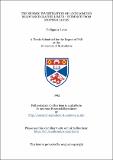Files in this item
The seismic investigation of Loch Lomond readvance glacier limits : evidence from Scottish lochs
Item metadata
| dc.contributor.advisor | McManus, John | |
| dc.contributor.advisor | Duck, Rob | |
| dc.contributor.author | Lowe, Philippa A. | |
| dc.coverage.spatial | 436 p., 25 p. of plates. | en_US |
| dc.date.accessioned | 2018-07-12T08:23:13Z | |
| dc.date.available | 2018-07-12T08:23:13Z | |
| dc.date.issued | 1993-07 | |
| dc.identifier.uri | https://hdl.handle.net/10023/15272 | |
| dc.description.abstract | This study presents a comparative examination of three lochs, located in the S.E. Grampian Highlands, using seismic reflection survey techniques. Lochs Callater, Muick and Lee, lying inside, across and outside probable Loch Lomond Readvance glacier limits respectively, were surveyed using echosounder (200kHz), Pinger (3.5kHz) seismic subbottom profiling, and sidescan sonar equipment. Calibration of seismic records was achieved through analysis of core and surface sediment samples. Geomorphological maps of the subaerial topography were drawn. Construction of bathymetric charts of the lochs reveals significant subaqueous topographic variation. The Loch Muick trough contains numerous mounds and hollows, and is crossed by a series of broken ridges, extending up the basin sides. Pinger profiling indicates that these subaqueous landforms are composed of glacial diamict (Sequence 2, Facies 2.1) overlain by draped sediments (Sequence 1). Additional ridges, buried beneath glacigenic outwash (Facies 2.2), are recognised 1.4km beyond the subaerial margin. It is suggested that the ridges are sublacustrine moraines. Analysis of core material suggests formation of these features during the Loch Lomond Readvance. Two sequences are recognised in Loch Callater; lacustrine sediment, and glacial diamict. Analyses of core sediment suggest respective Holocene and Loch Lomond Stadial ages of the sequences. Pollen analysis indicates that ice may have remained in Glen Callater into the Ninth Millenium. Within Loch Lee, below Sequence 1 (Holocene lacustrine sediment), the Loch Lomond Stadial is represented by glacigenic outwash (Sequence 2, Facies 2.1) and nearshore avalanche detritus (Facies 2.2). Sequence 3 is composed of outwash (Facies 3.2) and glacigenic diamict (Facies 3.1), of proposed Devensian age. The seismic signatures of the loch sediments are assimilated as a model. It is important that the limits of glaciation in the lacustrine environment be examined as extensively as those in the subaerial environment, to provide an accurate database against which models of climatic change can be tested. | en_US |
| dc.language.iso | en | en_US |
| dc.publisher | University of St Andrews | |
| dc.subject.lcc | QE579.L7 | |
| dc.title | The seismic investigation of Loch Lomond readvance glacier limits : evidence from Scottish lochs | en_US |
| dc.type | Thesis | en_US |
| dc.contributor.sponsor | Natural Environment Research Council (NERC) | en_US |
| dc.type.qualificationlevel | Doctoral | en_US |
| dc.type.qualificationname | PhD Doctor of Philosophy | en_US |
| dc.publisher.institution | The University of St Andrews | en_US |
This item appears in the following Collection(s)
Items in the St Andrews Research Repository are protected by copyright, with all rights reserved, unless otherwise indicated.

